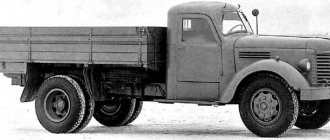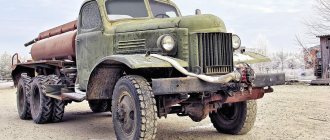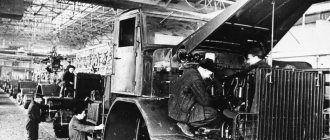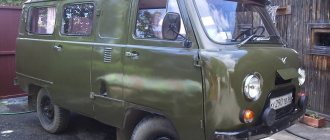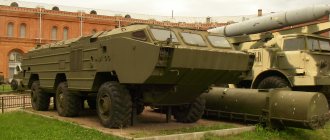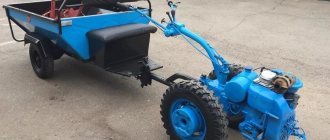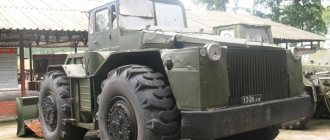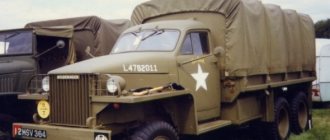GAZ-63 was created to replace the famous “polundra” (GAZ-AA), which, although it was an excellent truck, its rear-engine layout did not always cope with the pre- and post-war roads (or rather, the lack thereof) of the USSR. Work on creating a new all-wheel drive truck began at GAZ back in 1938, but the Great Patriotic War prevented it from finishing what was started. Although in 1939 a prototype GAZ-63 was manufactured, on the basis of which it was planned to create a whole family of similar cars and even armored cars, the car was never able to go into production before the start of the war.
Historical reference
The development of this truck began in the pre-war period, in 1938. During the era of World War II, American trucks were assembled at the Gorky Automobile Plant based on various parts supplied from the United States, but the design of a domestic off-road vehicle did not stop for a minute. And in February 1943, designer Lipgart reported to Stalin about the creation of the GAZ-63 all-wheel drive vehicle. After this meeting, the engineer received the go-ahead from the state leadership for the post-war production of the machine.
Car history
The design of the machine started back in 1938. The well-known “one and a half” trucks were already morally and technically outdated and needed to be replaced. Because of this, as soon as the spring of 1938 arrived, the design staff in Gorky began to develop a new truck, or, more specifically, a whole family of trucks with increased cross-country ability that could be operated in difficult road conditions.
Debut prototypes of the 63rd model were created before the Great Patriotic War in 1939 and 1940, but they began to be mass-produced in 1948. It was the most popular all-wheel drive vehicle of the Soviet Army, as well as the national economy of the Union of Soviet Socialist Republics in the period 1950-1960s. In this article you can find the dimensions of the car and find out information about the engine.
As an experimental model, a trial version was built in 1939 and put into testing. Since during the development of the new car the main focus was on its all-terrain properties, the off-road car did not differ in unique external properties.
As a cabin, the prototype had an existing version of a semi-truck. However, this was not so important, because the car's suspension was original. The 63rd model became the debut truck with increased cross-country ability, which had a 4x4 drive and single-pitch tires.
Simultaneously with the development of the off-road version of the Gorky Automobile Plant, work began on designing a civilian model of the GAZ-11-51 truck (as the GAZ-51 later became). It is noteworthy that many spare parts of Lawn-63 were unified with it.
Thanks to this, the main components became similar, and it was possible to make the production of new machines much cheaper, operation was simplified, and what is more important, a common conveyor was used for their production. Some design developments and technical solutions, which were used on the 51st and 63rd models, were revolutionary for those years.
For example, when compared with pre-war cars, new cars had a completely different layout - the power unit was installed above the front axle, which made it possible to increase the vehicle's carrying capacity while reducing their length. The brake system has acquired hydraulic mechanisms.
The GAZ-63 truck was very similar to the American version of the trucks, even despite the changes in design.
Despite the successful completion of all tests and recommendations for release, it was not possible to set up their production in the early 1940s - the outbreak of the Great Patriotic War was to blame. Work on the design of successful vehicles continued in 1943, after Russian troops drove the Germans to the west.
It is worth admitting that by that time, only indices remained from the machine designed in pre-war times - wartime made its own adjustments, and a few years later, scientific and technical achievements moved forward. Moreover, the design composition of the automobile with trucks having all-wheel drive, which were produced in America.
These were Studabeker and Chevrolet. During wartime, under Lend-Lease, they were produced here at the Gorky Automobile Plant. It is clear that the engineering staff simply could not miss this chance to take some parts of the design developments from their colleagues from America. But the main components were designed only by the Russians, or they were improved from those already present.
An experimental batch of new all-terrain trucks, which were ready for various tests, was produced in 1945, after the cars were approved by the country's leadership in the person of Stalin and party leaders. Conveyor production of the 63rd Lawn took place only in the fall of 1948, which is a couple of years later than the GAZ-51.
This all-terrain vehicle with increased technical characteristics and excellent cross-country ability was able to be adequately appreciated by the Soviet Army. GAZ-63 could not be afraid of sticky soil, a ford, the depth of which reached 80 cm, almost half a meter of loose snow cover, and 70-centimeter ditches. The model was actively used for transporting army personnel, as a tug for military guns and for installing various combat installations.
The car was a very good helper, as it was not afraid of off-road conditions and could transport, in addition to its own cargo, trailers whose weight reached 2 tons.
The national economy of the “sixty-third” model also found its own application, but the Lawn was not used so often, and mostly in the countryside. When the war ended, the number of trucks was very small, especially in some remote areas, and the need for freight transportation was simply catastrophic, so considerable overloads were considered normal.
It is clear that few could doubt the reliability of the design of the vehicles, however, as the load increased, the cross-country ability of the vehicles greatly decreased, for which, in general, the GAZ-63 was created. Moreover, parts began to wear out more, and it was difficult to carry out timely maintenance of vehicles for rural needs, as was done in the army.
The all-wheel drive system on rural off-roads was just in time, but the advantages of the model with only slopes raised many questions. Some drivers themselves modernized the car, and after a while, the plant began to produce modifications with paired rear wheels. Also, one of the shortcomings could be called the insufficient stability of the truck.
The all-wheel drive version of the Lawn had a narrow track and a high-mounted body (ground clearance was 270 millimeters), due to which drivers could often “lay” the car on its side when entering a turn at high speed.
Then in 1968, the model gave way to a new car - the GAZ-66. The percentage of standardization of the car with the famous GAZ-51 was 80%. The total number of cars produced was 474,464 units.
Model 1943
GAZ-63, the photo of which is given below, was assembled in the fall of 1943 and had significant differences from its pre-war brother. In particular, it was equipped with L-shaped welded fenders, protective grilles on the headlights and a cabin made in accordance with the American counterparts of 1942, supplied under Lend-Lease.
The carburetor-type engine had six cylinders and was liquid cooled with a pre-heater. In order to quickly adapt the engine to changes in external load indicators, the intake and exhaust channels were artificially “strangled”. The maximum power was 70 horsepower. The speed reached 2800 rpm.
In addition, the developers shifted the front axle housing to the left of center. Parts produced were used as CV joints.
Design features of the GAZ-63
The truck is distinguished by a frame design, an all-wheel drive system with a switchable front axle (a pair of cardan shafts to the drive axles plus an intermediate one between the gearbox and transfer case), short overhangs (small overhang - large departure or approach angle) and single wheels with powerful tires. tread. By the way, in those years all trucks were still framed: trucks with semi-supporting or load-bearing bodies (like on a passenger car chassis) did not yet exist.
The tires of the GAZ off-road truck had a size of 10.00–18″. The pressure in them could be changed when overcoming various types of off-road conditions, within the range from 4 to 0.5 kgf/cm2. There were no compressors at that time, so to inflate tires in field conditions, a device was used that was located under the body, was switchable, and driven by a gearbox.
Later, a tire inflation device from the engine appeared, screwed into place of one of the spark plugs. At the same time, the engine operated on five cylinders, and the piston of the sixth cylinder pumped compressed air into the truck tires. However, one should not think that the tires were inflated in this way not with air, but with a gasoline-air mixture. Since the inlet air valve of the device had significantly less resistance than the intake manifold and carburetor with an inertia-oil air cleaner. Although a small portion of gasoline vapors certainly got into the inflated tire.
On off-road roads in those days, the GAZ-63 had practically no worthy competitors (not counting the ZIL-151).
An interesting feature of the GAZ-63 design is its extremely simple and effective engine preheating system. A special preheating boiler was mounted under the hood, on the right side of the engine. In frosty weather, you had to turn the steering wheel all the way to the left, open the hatch in the fender of the right front wheel, and insert a lit blowtorch into the fire tube of the boiler.
In this way, the liquid in the cooling system was heated, as well as the engine oil in the oil pan. When heating a “dry” engine, five liters of water were poured into the boiler, after which it was heated with the resulting steam. Then start the engine and add water to the radiator.
What is typical is that the GAZ-63 of the first years of production was equipped with engine pre-heaters, but they did not have a heater in the cabin at all! In winter, it was necessary to work in such a machine not only in a padded jacket, but preferably even in a warm sheepskin sheepskin coat, high boots and thick mittens.
But, starting in 1952, the design of the car already included a standard factory heater for the cabin. By means of an electric fan, warm air was supplied to the windshield, and it was supplied to the feet of the seated driver and passenger when the car was moving, through an air intake that opened behind the hood.
Access to the engine for maintenance and repair, as well as for cooling, was greatly simplified thanks to the removable side panels of the hood trim.
Distinctive feature
The GAZ-63 in its first models had fairly wide tires (from 9.75 to 18 inches), as well as single wheels on the rear axle, which had exactly the same track as their front “brothers”. This was done so that when the car was driving on snow, mud, sand, absolutely all the wheels would follow each other on the same track, without experiencing strong resistance to their rolling on the underlying surface due to the difference in track width. Somewhat later, during tests of all-wheel drive vehicles, the GAZ-63 was able to show “record performance in its cross-country ability” (quote based on a report by military experts) and was even used as a tractor for towing ZiS-151 stuck in the mud. These capabilities of the machine were appreciated.
Ural Airlines received the first Airbus A320neo
Airbus A320neo of Ural Airlines. Photo: press service of the airline August 8, 2022, — The Ural Airlines fleet has been replenished with a narrow-body passenger jet of the Airbus A320neo family. See photos from the presentation of the new aircraft below.
“At 02:30 at night our first Airbus A320neo landed,” the company announced on its Instagram page.
The press service of Ural Airlines clarified that this aircraft, like the previous ones, was purchased under operating lease.
The airline already operates 45 aircraft manufactured by Airbus (twenty-four A320s, sixteen A321s and five A319s). Now it will increase to 46 units.
As reported, by the end of the year the company intends to lease four Airbus aircraft. Their deliveries were supposed to begin earlier, but, as Ural Airlines CEO Sergei Skuratov told Interfax, the delay was caused by problems with CFM International engines (a joint venture between the French Snecma and the American GE Aviation).
Special offer on air tickets
- Ekaterinburg – Moscow – one way – from 1,999 ₽ View
- Ekaterinburg – Sochi – one way – from 2,460 ₽ View
- Ekaterinburg – Simferopol – one way – from 3,732 ₽ View
S7 airline was the first in the Russian Federation to operate the A320neo in 2022, but its aircraft are powered by American Pratt & Whitney PW1100G engines.
For Ural Airlines, the A320neo with tail number VP-BRX was the first of seven aircraft of the A320neo family that they planned to receive in 2022. The new aircraft arrived from the Airbus plant in Toulouse and is being delivered as part of a three-aircraft contract with Chinese leasing company CDB Aviation .
The airline also plans to replenish its fleet with Boeing aircraft. In the spring of 2022, Ural Airlines entered into an agreement with an American corporation to lease 14 Boeing-737 MAX8. Delivery was expected from October 2022 to May 2022, and the company now expects delivery of the first Boeing 737 MAX8s on order in December. However, there is one problem - the operation of these aircraft is prohibited. Therefore, it is not clear how the airline is going to operate the Boeing 737 MAX 8.
Ural Airlines is the largest Russian airline. Based in Yekaterinburg. Operates regular domestic and international flights, as well as charter flights. The Ural Airlines fleet consists of Airbus A320 family aircraft. In 2022, the carrier received an award from the Safety Leaders Award in the category “Transport Safety: Aviation Security.”
Airbus A320neo of Ural Airlines. Photo: aviation press service class=”aligncenter” width=”2560″ height=”1645″ Airbus A320neo Ural Airlines. Photo: aviation press service class=”aligncenter” width=”2560″ height=”1647″ Airbus A320neo of Ural Airlines. Photo: aviation press service class=”aligncenter” width=”2560″ height=”1638″ Airbus A320neo Ural Airlines. Photo: aviation press service class=”aligncenter” width=”2560″ height=”1641″ Airbus A320neo of Ural Airlines. Photo: aviation press service class=”aligncenter” width=”2560″ height=”1648″ Airbus A320neo Ural Airlines. Photo: aviation press service class=”aligncenter” width=”2560″ height=”1648″ Airbus A320neo Ural Airlines. Photo: aviation press service class=”aligncenter” width=”2560″ height=”1643″ Airbus A320neo Ural Airlines. Photo: airline press service
Brake system and clutch
The GAZ-63 was equipped with a single-plate dry clutch. A hydraulically driven shoe unit was used as a service brake for all wheels. The parking brake was of the drum type and had a mechanical drive.
The suspension on all wheels was dependent and was installed on semi-elliptical springs. At the same time, the front suspension was equipped with double-sided hydraulic shock absorbers. The steering mechanism included a double-ridge roller and a globoid worm.
A little about the engine.
Cruiser "Aurora": history of creation and use in war, design and technical characteristics, military weapons, advantages and disadvantages
The history of this engine dates back to 1928, when the Dodge D5 six-cylinder lower valve engine was developed in the USA. The engine developed a fairly large specific power for that time, 22-24 hp/liter, and was at the same time fantastically reliable. Then, in the twenty-eighth, the engine featured such technical innovations as replaceable bimetallic crankshaft bearing shells, a thermostat in the cooling system, 100% oil filtration, insertable heat-resistant exhaust valve seats, a crankcase ventilation system, automatic ignition timing, oxidized pistons , floating oil receiver. The engine was very technologically advanced, and no non-ferrous metals were used for the manufacture of its parts, with the exception of the pistons.
The Dodge D5 had cylinders with a diameter of 3¼ inches (82.55 mm), a stroke of 4 and 3/8 inches (111.1 mm), and its displacement was equal to 3560 cc. cm.
| Gas-51 |
| Tests of the GAZ-51 1946 car. On the left is leading designer A.D. Prosvirin |
In 1937, GAZ chief designer Andrei Lipgart went to the USA to select a prototype of the new GAZ engine, which was supposed to be installed on a modernized emka. After comparing many samples, he chose D5. In the Union, the engine was converted to metric dimensions. The cylinder diameter was rounded to 82 mm, and the piston stroke to 110. As a result, the working volume was reduced to 3485 cc. cm. The compression ratio, on the contrary, was increased from 5.6 to 6.5 units, as a result of which the engine power increased from 76 to 85 hp. It was in this form that the engine was installed on the Emka, calling this modification GAZ-11-73. The same engine was installed on its all-wheel drive version of the GAZ-61.
However, on the GAZ-51
a derated version was installed, which developed only 70 hp. The compression ratio in it was left American, so that instead of 66 gasoline, 56 gasoline could be used.
In May and September 1944, two new models of GAZ-51
with various design options for the front end, and in June 1945 they created two more fully developed pre-production samples. On June 19, 1945, the GAZ-51, along with other new Soviet cars, was shown to Stalin and members of the government in the Kremlin.
Already at the end of 1945, an initial batch of two dozen vehicles was produced, and in 1946, even before testing was completed, 3,136 production trucks were produced.
GAZ-51 performance
significantly exceeded not only the lorry, but even the ZiS-5, while consuming fuel 28% less than the lorry and 36% less than the ZiS-5.
In 1955, the car underwent modernization, after which it received the GAZ-51A index, a disc parking brake, and a year later the body became longer and higher, which now had three folding sides.
| Gas-51 |
| GAZ-51 was used not only to transport goods, but also passengers. In rural areas, collective farmers were transported in its back to the site of field work and back. Kolkhoz named after Michurin, Alma-Ata region, 1955. |
In a short time, the GAZ-51 became the most common car in the Land of the Soviets. In 1958, the annual production of the GAZ-51 reached its peak - 173 thousand units, but in the same year the GAZ-52 appeared, and the production of the Lawn began to decline. The last GAZ-51A rolled off the assembly line on April 2, 1975 and was sent to the factory museum. The total circulation of Lawns was 3,481,033 units. Under Soviet license, the GAZ-51 was produced in Poland, and in North Korea, they say, it is still produced.
In addition, the GAZ-51 truck chassis was used to create the KAVZ-651 and PAZ-652 buses.
The GAZ-51 was widely used in the Soviet Army: a modification of the GAZ-51N was created specifically for transporting soldiers, with a lattice body with seats along the sides and an additional 105-liter fuel tank. The cabin roof of this modification was often made of canvas. An all-wheel drive version of the GAZ-51, called the GAZ-63, was also developed for the army.
GAZ-51 was exported. The main buyers were the countries of the socialist camp, but it was also found in capital markets. Cases of using the GAZ-51 as a trophy are of interest. The Americans, who captured it in Korea, made guntrucks and even railcars at its base.
Transfer case
This unit was installed on the vehicle in such a way that the driveshafts with which it was connected to the truck axles were of the same length. The box was also coupled with a range multiplier, with the help of which a very significant expansion of the range of traction force applied to the drive wheels occurred - from 6.4 to 12.5.
It is worth noting that the multiplier, in addition to downshift, also had direct transmission. This made it possible to reduce mechanical losses in the entire transmission and, accordingly, fuel consumption while driving on good quality roads. If necessary, the front wheel drive could be turned off for the required period of time.
Unhurried KShM
On a gloomy, damp morning in the middle of the Moscow winter, we arrived at the base of the MILITARY-TECHNICAL SOCIETY. Everyone who started their personal driving career in the USSR knows very well that the process of preparing a car for operation in the first half of the twentieth century is somewhat different from the current one, especially in winter. But it turned out that I was not faced with the tedious procedures of pre-heating and filling the cooling system with water due to the car being stored in a warm box. Moreover, the gas car is completely complete, which means you don’t have to look for a battery and rush for low-octane gasoline, which has almost disappeared in the capital region. Everything here was taken care of before me.
By turning the flag (this is military equipment), I turn on the ignition, closing the carburetor air damper, and to turn on the starter, I use a special pedal located just above the accelerator pedal. Just a couple of turns of the starter and the lower-valve “six” comes to life and, surprisingly, works quietly and smoothly - you can’t hear any valves, no noise from the bearings of attachments, or the whistling of the belt drive of auxiliary units! And the smell from the exhaust pipe immediately reminded us that this was a well-deserved example of automotive technology.
Having waited for the water temperature to reach 40 °C, I slow down to a steady idle and, turning on the unsynchronized 1st gear with a characteristic sound, gradually swaying with springs from side to side, we roll out to the improvised training ground of an armored repair plant. And now - let's go!
With a maximum rated speed of 65 km/h, the cruising speed of a military vehicle is half that. In general, the machine is hyper-slow, but everything works surprisingly clearly: gear shifting, front axle connection, and range control. But even at such a snail’s speed, all manipulations with the steering wheel, brakes, and transmission control levers must be done in advance and with a huge margin.
However, flimsy brakes and a tight steering wheel with a million revolutions from the edge of the left to the edge of the right will not allow it otherwise, but the elastic low-end engine forgives premature gear shifting up, although it puffs a little indignantly. With maximum use of all the capabilities of the transmission, the GAZ-63 rows absolutely confidently through mud, loose snow and in deep ruts, I even tried to drive onto a completely icy overpass, but the speed drops to walking values, you can feel the lowest gear ratios of the transmission right behind you. However, we do not forget that the purpose of this transport is completely different, and tube radio equipment weighs quite a bit.
Short wheelbase, heavy KUNG, soft springs, and, as a result, large rolls and a real risk of falling on one side in a dashing turn or when storming a slope. True, old drivers note this feature in the basic GAZ-63, even with an ordinary wooden flatbed without an awning. You need to monitor the operation of the engine using the organs of smell and touch, but there is also good information on the instrument panel: ammeter, speedometer and odometer, temperature gauge, fuel level gauge, oil pressure gauge, all instruments under the patronage of a pair of reflected light bulbs to see the scales in Night time. Rear-view mirrors, and even in the army, at that time were considered more like beautiful accessories than mandatory and necessary equipment, so according to legend, you will have to do without them.
We ride, pose, film, but it’s time to return to the cozy, warm box. But nevertheless, after parking, just like in the morning, you won’t be able to simply close the doors and go home. It is better to drain the water, then you need to turn off the fuel line tap and turn off the ground; It is advisable to install wheel chocks so as not to strain the parking brake. These mandatory procedures have long been forgotten by modern drivers.
Body
The military GAZ-63 was equipped with a wooden universal body, which had high lattice side sides and a front wall. Inside there were folding longitudinal benches. The tailgate was also made to open. The side boards had special sockets into which arcs could be installed to tension the awning.
Based on the requirements of the military leadership, the designers increased the capacity of the fuel tanks. A 105-liter tank was added to the main ninety-liter tank, which made it possible to increase the fuel volume to 780 kilometers at full load.
Cabin interior
The cabin was double.
There was not much free space inside the car, and the heater began to be installed only after 4 years, when mass production of the car began. The driver's seat had no adjustments and was quite simple, but not hard. But what more can you ask for from an army SUV of this year? After all, back then they thought little about comfort, the main thing was to make a technically well-equipped car, and so that it could drive almost anywhere, including off-road. Many models had an iron dashboard, on which a large three-spoke steering wheel could be found on the left.
Next to it was the dashboard, on which there was a speedometer in a large circle, numbered to 100 km/h. On the far left side was the fuel level sensor, and below that was the oil level sensor.
To the right of the speedometer there is a water temperature sensor and an ammeter. There was even a place for a glove compartment where you could put all the necessary things. The windshield was divided into two parts.
Modifications
GAZ-63 (the photo of the car allows you to evaluate its appearance) also had its own modification, 63A. This car had an elongated frame, at the front end of which an electric winch or generator was installed, driven by a driveshaft connected, in turn, to the transmission. The winch had a 65-meter cable and had a traction force of 4500 kilograms.
Special vehicles based on an SUV
Fuel tankers, oil tankers, milk tanks, vans, mobile repair shops, staff and medical buses, disinfection units, auger-rotor vehicles were assembled on the basis of the GAZ-63. A firefighting vehicle for communication and lighting, and tank trucks of several modifications were produced by the Vargashinsky Fire-Fighting Equipment Plant. Staff and hose fire trucks were produced at the Moscow Fire Truck Plant.
For the military, in addition to basic models, staff and medical buses, shielded warm and sealed communication vehicles, disinfection and shower units DDA-53A were produced for sanitary treatment of personnel in the field, disinfection and disinsection of uniforms and equipment. The installation was equipped with a steam boiler running on liquid fuel or wood, the operating pressure of which was four atmospheres, an accumulator boiler, a hand pump, a steam elevator, control equipment, two open disinfection chambers and shower cabins with twelve shower nets.
Technical specifications
The GAZ-63, whose technical characteristics were optimal for the period of its development, was produced until 1968. Over the entire period of its production, 474,464 cars rolled off the assembly line, including export versions. The main technical indicators of the machine were:
- The wheel formula is four-wheel drive on all wheels.
- Number of places – 2.
- Length – 5525 mm.
- Width – 2200 mm.
- Height – 2245 mm.
- Ground clearance – 270 mm.
- Load capacity indicator – 2000 kg.
- The weight of the towed trailer is 2000 kg.
- Engine type - GAZ-51.
- Engine capacity – 3485 cc. cm.
- The maximum travel speed is 65 km/h.
- Fuel consumption is 30 liters per 100 km.
- Curb weight – 3280 kg.
Price
The GAZ-63 truck was discontinued from mass production a long time ago. But even now you can find completely working copies.
Thus, a car in working condition can now be purchased at a minimum price of 80 thousand rubles. However, when buying this option, you should remember that for such a price, equipment in most cases requires painstaking restoration.
Another option, and a very popular one, is to purchase a truck that was taken out of military storage in the 1980s and 1990s. Most often, such machines are equipped with KUNGs and are in excellent technical condition. The cost of this option on average reaches 450 thousand rubles, depending on the equipment.
Professional opinion
In general, the GAZ-63 proved itself quite well in practice, but it had a significant design flaw, which in Soviet times was not very fond of being mentioned: the developers of the vehicle did not quite correctly determine the ratio of the track width to the position of the truck’s center of gravity. In this regard, operation showed that the car, which had decent cross-country ability, had poor lateral stability, which led to it tipping over when entering turns with a small radius or driving on slopes. A driver who incorrectly calculated the required speed for driving around a corner very often put the car on its side.
Owner reviews
The Ural M-63 motorcycle is a true legend of the Soviet automotive industry. Its maneuverability and power are impressive. Owners of the unit highlight the following advantages:
- Spacious side trailer along with high load capacity.
- Powerful power unit, reliability.
- Soft suspension, ease of operation and repair.
- Thoughtful design of lighting elements.
Like any technology, the vehicle in question has its drawbacks. Consumers among them note high fuel consumption, difficulty driving without a stroller, hard seats and a weak battery for such a weight.
Modernization
They tried to eliminate the identified deficiency already in 1954. For this purpose, two modernized models of the car were created: GAZ-63V and GAZ-63 AB. However, in the end, the customer completely rejected these options, since, in his opinion, the existing shortcomings were not leveled out. Of course, engineers continued to try to find a solution to the problem, but practice showed that it was much easier to create a completely new car than to improve an old one.
Subsequently, on the basis of the “sixty-third”, such special-purpose vehicles were created as: an armored personnel carrier, a tanker, an ambulance, a rocket artillery vehicle and others.
In 1952, the production of AS-3 ambulances with a van body, which was designed for seven lying patients and two sitting ones, was mastered. Next, the ASh-3 headquarters vehicle was created.
In 1959, by order of the defense department, several copies of PAZ-654 staff buses were created based on the GAZ-63 chassis. Moreover, their internal “stuffing” consisted of tables, seats, radio equipment, fire extinguishing equipment, and devices for holding small arms.
In 1962, a car carrying containers for transporting nuclear waste was developed. It was based on the GAZ-63, only with a smaller chassis. At the same time, the base of the machine was also lengthened and an auxiliary driveshaft and additional support were installed. The machine was equipped with a special crane-reloader PSh-04. Thanks to this, the replacement body was located at a distance of almost 4 meters from the driver’s cab. This ultimately made it possible to do without the use of a special lead screen, which would have weighed a thousand kilograms.
Semi-trailers-dumpers
Zil-164 is the most famous Soviet truck of the 1960s
Perhaps the most interesting in terms of design were the self-unloading semi-trailers for gas cars, which primarily include the T-40 dumping semi-trailer with a mechanical dumper. This model, manufactured by Glavlenavtotrans since the late 1960s, was intended for the transportation of long cargo in tandem with the GAZ-51P tractor. The features of the T-40 were: firstly, structural similarity with a standard trailer with a longer length and a fifth-wheel coupling method of connection to the tractor; secondly, the process of self-unloading in the form of tilting both bunks to one side (by releasing certain latches) together with the opening of their side posts on the corresponding side.
Another interesting development in this area was a road train consisting of a GAZ-51A tractor and a dump truck semi-trailer, created in the early 1960s for the transportation of bulk construction materials. Unfortunately, the authorship of this semi-trailer remains unknown, but it is known that its subsequent production was not industrial, since such dumping road trains were manufactured by the motor transport enterprises themselves in the systems of the Ministry of Construction and the Ministry of Avtotrans. The features of this unnamed dump truck include: a short wheelbase and a two-level semi-trailer frame, a corresponding two-level bottom of an all-metal welded dump body with a hinged rear wall, and a hydraulic dump mechanism driven by a tractor equipped with a power take-off (PTO).
And finally, another tipper semi-trailer was the rare, although quite well-known, 4-ton GAZ-707, developed in Gorky by order of the Ministry of Agriculture of the Uzbek SSR for the transportation of unpackaged raw cotton. One of its first samples was exhibited in 1958 at VDNH in Moscow. Others were tested in Uzbekistan, and soon their mass production was mastered by Tashkent.
GAZ-707 self-unloaded on two sides, and the body was lifted by two rack and pinion jacks. From the engine, through the PTO and a system of cardan shafts and gears, a gear located in the saddle of the tractor’s coupling device was driven into rotation. This gear engaged with a gear, the axis of which passed through a concentric hole in the semi-trailer's kingpin, and then, through a system of shafts and gears, the engine torque was transmitted to the gearboxes of the rack and pinion jacks located along the longitudinal axis of the semi-trailer. The body tilt to the maximum angle of 50° was achieved in 1–1.5 minutes. The hydraulic brake system of the semi-trailer was connected into one unit with the brake system of the tractor using a special device. The overall dimensions of the semi-trailer were 5400x2440x2050 mm (with extension sides - 3460 mm), body capacity - 11.13 m3 (with extension sides - 20 m3).
An interesting point here was the fact that the GAZ-707 was not intended for the GAZ-51P at all, but for its all-wheel drive version GAZ-63D. And in this regard, he was not alone.
The Mystery of KUNG
GAZ-63E R-125M KShM is a command and staff vehicle (KShM), identical to the R-125M “Alphabet” station based on the GAZ-69E passenger car, but mounted on the GAZ-63E chassis. Developed in 1956 by Zaporozhye. The R-125 command and staff vehicle was created to provide radio communications to unit commanders and service chiefs of the Ground Forces. Various VHF radios were used in various modifications of the KShM: the R-125 used the R-105D. The body was manufactured at a furniture factory in Rechitsa. The internal communication equipment (AVSK) provided the commander with communication with the radio operator and driver, including from the remote communication console in the parking lot, and communication with the desired subscriber via any of the channels provided in the communication center. Power supply for communications equipment was provided while driving from a generator through power take-off from the engine, and when parked - from an autonomous remote gasoline-electric unit (ABE), backup batteries were provided as an emergency power source for the equipment, which were recharged from the on-board network through a charger while driving.
